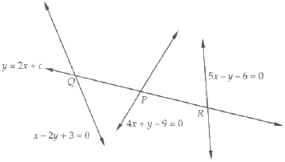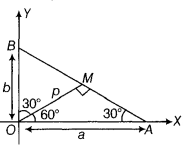Straight Lines - Test Papers
CBSE Test Paper 01
CH-10 Straight Lines
- The lines x + 2y – 3 = 0, 2x + y – 3 = 0 and the line l are concurrent . If the line I passes through the origin, then its equation is
- x – y = 0
- x + y + 0
- x + 2y = 0
- none of these
- Projection (the foot of perpendicular) from ( x , y ) on the x – axis is
- ( - x , 0 )
- ( 0 , y )
- ( x , 0 )
- ( 0 , - y )
- The distance of the point () from X axis is
- none of these.
- A line is drawn through the points ( 3 , 4 ) and ( 5 , 6 ) . If the is extended to a point whose ordinate is – 1, then the abscissa of that point is
- none of these
- 1
- 0
- - 2
- The line which is parallel to X axis and crosses the curve y = at an angle of is:
- y = 1/2
- y = 1
- none of these
- y =
- Fill in the blanks:
If a, b, c are in A.P., then the straight line ax + by + c = 0 will always pass through ________.
- Fill in the blanks:
The slope of the line, whose inclination is 150o is ________.
Prove that the line through the point (x1, y1) and parallel to the line Ax + By + C = 0 is A(x - x1) + B(y - y1) = 0.
Prove that the points A (1, 4), B (3, -2) and C (4, - 5) are collinear.
Find the equation of the line, where length of the perpendicular segment from the origin to the line is 4 and the inclination of the perpendicular segment with the positive direction of X - axis is 30o.
If a, b, c are variables such that 3a + 2b + 4c = 0, then show that the family of lines given by ax + by + c = 0 pass through a fixed point. Also, find the point.
Show that the lines 4x + y - 9 = 0, x - 2y + 3 = 0, 5x - y - 6 = 0 make equal intercepts on any line of gradient 2.
A line forms a triangle in the first quadrant with the coordinate axes. If the area of the triangle is sq units and perpendicular drawn from the origin to the line makes an angle 60o with X-axis, then find the equation of the line.
Find the equation of the straight lines which passes through the origin and trisect the intercept of line 3x + 4y = 12 between the axes.
A rectangle has two opposite vertices at the points (1, 2) and (5,5). If the other vertices lie on the line x = 3, find the equations of the sides of the rectangle.
CBSE Test Paper 01
CH-10 Straight Lines
Solution
- (a) x – y = 0
Explanation: Equation of a line passing through the intersection of two lies is given by ax1 +by1 +c1 + k(ax2 +by2 +c2) = 0Hence x+2y-3 + k(2x+y-3) = 0
Since it passes through (0,0)
-3 -3k = 0
This implies k = -1
Sustituting for k we get,
x+2y-3 +(-1)(2x+y-3) = 0
-x +y =0 or x - y = 0
- (c) ( x , 0 )
Explanation: Let L be the foot of the perpendicular from the X axis. Therefore its y coocrdinate is zeroTherefore the coordiantes of the point L is (x,0)
Hence option 1 is the correct answer
- (a)
Explanation:
The distance of a point from X axis is its y coordinate.
Hence the distance of the point () from X axis is || - (d) - 2
Explanation:The slope of the given line is = = 1
Therefore = 1
That is 4+1 = 3 - x
Therefore x = -2 - (a) y = 1/2
Explanation: The equation of the line which is a tangent to the curve y = is
y = mx + a/m
Since it makes and angle of 450, m = 1
y2 = x implies a = 1/4
Hence the equation of the tangent is y = x+That is the y intercept is = 1/2
Hence the equation of the line is y = 1/2 (1, -2)
Equation of the line parallel to line Ax + By + C = 0 is Ax + By + K = 0 . . . (i)
Since line (i) passes through (x1, y1)
Ax1 + By1 + K = 0...(ii)
Subtracting (ii) from (i), we have
A(x - x1) + B(y - y1) = 0Given points are A (1, 4), B (3, -2) and C(4, -5)
From the condition for collinearity of points A, B and C, we have
The slope of AB = Slope of BC.
which is true.
Hence, points A, B and C are collinear.The normal form of the equation of the line is x cos + y sin= p
Given, p = 4, = 30o. Therefore, the equation of the line is x cos 30o + y sin 30o = 4.
+ y = 8We have, 3a + 2b + 4c = 0
On substituting this value of c in ax + by + c = 0, we get
This equation is of the form , which represents a straight line through the intersection of the Line L1 = 0 and L2 = 0 i.e.,
On solving these two equations, we get the point which is a fixed point.The equation of any line of gradient 2 is
y = 2x + c ...(i)
The equations of given lines are
4x + y - 9 = 0 ...(ii)
x - 2y + 3 = 0 ...(iii)
5x - y - 6 = 0 ...(iv)
Solving (i) with (ii), (iii) and (iv) respectively, we obtain the coordinates of P, Q and R as
P , Q and R
Clearly, P is the mid-point of QR. Therefore PQ = PR.
Hence, lines (ii), (iii) and (iv) make equal intercepts on any line of gradient 2.Since, OM is the perpendicular line on AB.
Here,
Let OM = p, OA = a, OB = b
In
In
[given]
p2 = 81 p = 9 [ distance is always positive, so we take positive sign]
Using normal form of the equation of line AB is
x cos + y sin = p
x cos 60o + y sin60o = 9The given line is 3x + 4y = 12 ...(i)
Let the line (i) cuts X and Y-axes at A and B, respectively.
Then, A = (4, 0) and B = (0, 3).
Let the line AB be trisected at P and Q, then
AP : PB = 1 : 2
and AQ : QB = 2:1
Also,
Now, equation of line OP passing through (0, 0) and is
3x - 8y = 0
And equation of the line OQ passing through (0,0) and is
2y = 3x 3x - 2y = 0Let ABCD be a rectangle whose two opposite vertices are A (1, 2) and C (5,5).
Let the coordinates of the other two vertices B and D of rectangle ABCD be B (3, y1) and D (3, y2). Since diagonals, AC and BD bisect each other. Therefore, the mid-points of AC and BD are the same.
y1 + y2 = 7 ...(i)
Since ABCD is a rectangle.
AC = BD
AC2 = BD2
(1 - 5)2 + (2 - 5)2 = (3 - 3)2 + (y1 - y2)2
16 + 9 = (y1 - y2)2
y1 - y2 + 5 ....(ii)
Solving (i) and (ii), we get
y1 = 6 and y2 = 1 or, y1 = 1 and y2 = 6
Thus, the coordinates of B and D are B (3,1) and D (3, 6).
The equation of side AB is
y - 2 = (x - 1) or, y - 2 = - (x - 1) or, x + 2y - 5 = 0
The equation of side BC is
y - 1 = (x - 3) or, y - 1 = 2(x - 3) or, 2x - y - 5 = 0
The equation of side CD is
y - 5 = (x - 5) or, y - 5 = - (x - 5) or, x + 2y -15 = 0
The equation of side AD is
y - 2 = (x - 1) or, y - 2 = 2 (x - 1) or, 2x - y = 0